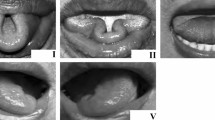Abstract
Twenty-seven patients with vocal fold motion impairment underwent detailed pharyngoesophagel manometry with a strain gauge assembly linked to a computer recorder. Nine were known to have lesions of the central vagal trunk or nucleus, 9 had recurrent laryngeal nerve (RLN) palsy, and the remainder were idiopathic. The site of the lesion was a more important determinant of subjective swallowing performance than the position of the involved cord at laryngoscopy. Patients with cental lesions had lower tonic and contraction upper esophageal sphincter (UES) pressures than 25 age-matched controls, suggesting that high cervical branches of the lower cranial nerves are important in UES excitatory innervation. RLN palsy patients showed significantly increased pharyngeal contraction amplitude and reduced pharyngoesophageal wave durations. The results suggest that the dysphagia associated with vocal fold motion impairment is not simply due to the disruption of laryngeal deglutitive kinetics, but to independent effects on pharyngeal function.
Similar content being viewed by others
References
Lund WS, Ardran GM: The motor nerve supply of the cricopharyngeal sphincter. Ann Otol Rhinol Laryngol 53:353–367, 1964
Mebis J, Ramaekers D, Geboes K, Desmet V, Vantrappen G: The human pharyngo-esophageal sphincter has a characteristic neural and vascular supply. (Abstract) Gastroenterology 100:S468, 1991
Rontal E, Rontal M, Morse G, Brown EM: Vocal cord injection in the treatment of acute and chronic aspiration. Laryngoscope 86:625–634, 1976
Woo JKS, Hassett CA van, Chan HS: Teflon injection for unilateral vocal cord paralysis and its effect on lung function. Clin Otolaryngol 17:497–500, 1992
Ardran GM, Kemp FH: The protection of the laryngeal airway during swallowing. Br J Radiol 25:406–416, 1952
Reynolds RPE, Effer GL, Bendeck MP: The upper esophageal sphincter in the cat: the role of central innervation assessed by transient vagal blockade. Can J Physiol Pharmacol 65:96–99, 1987
Shin T, Umezaki T, Maeyama T, Morikawa I: Glottic closure during swallowing in the recurrent laryngeal nerve-paralysed cat. Otolaryngol Head Neck Surg 100:187–194, 1989
Hwang K: Mechanism of the functional recovery of the cervical portion of the esophagus after bilateral resection of the pharyngoesophageal nerve in the dog. Am J Physiol 174:231–234, 1953
Henderson RD, Boszko A, vanNostrand AWP: Pharyngoesophageal dysphagia and recurrent laryngeal nerve palsy. J Thorac Cardiovasc Surg 68:507–512, 1974
Wilson JA, Pryde A, Macintyre CCA, Heading RC: Normal pharyngoesophageal motility: a study of 50 healthy subjects. Dig Dis Sci 34:1590–1599, 1989
Ward PH, Berci G: Observations on so-called idiopathic vocal cord paralysis. Ann Otol Rhinol Laryngol 91:558–563, 1982
Sasaki CT, Horiuchi M, Ikari T, Kirchner JA: Vocal cord positioning by selective denervation: old territory revisited. Ann Otol 89:541–546, 1980
Miller AJ: Neurophysiological basis of swallowing. Dysphagia 1:91–100, 1986
Shaker R, Dodds WJ, Dantas RO, Hogan WJ, Arndorfer RC: Coordination of deglutitive glottic closure with oropharyngeal swallowing. Gastroenterology 98:1478–1484, 1990
Miller AJ: Characteristics of the swallowing reflex induced by peripheral nerve and brainstem stimulation. Exp Neurol 34:210–222, 1972
Jacob P, Kahrilas PJ, Herzon G, McLaughlin B: Determinants of upper esophageal sphincter pressure in dogs. Am J Physiol 259:G245-G251, 1990
Aharinejad S, Firbas W: Die Innervation des menschlichen Osophagus. Acta Anat (Basel) 136:715–720, 1989
Hudson LC, Cummings JF: The origins of innervation of the esophagus of the dog. Brain Res 326:125–136, 1985
Khurana RK, Petras JM: Sensory innervation of the canine esophagus, stomach and duodenum. Am J Anat 192:293–306, 1991
Cunningham ET, Sawchenko PE: Central neural control of esophageal motility: a review. Dysphagia 5:35–51, 1990
Altschuler SM, Bao XM, Miselis RR: Dendritic architecture of nucleus ambiguus motoneurons projecting to the upper alimentary tract in the rat. J Comp Neurol 309:402–414, 1991
Yang M, Zirkle MS, Zhao XS, Miselis RR, Altschuler SM: Brainstem localisation and connectivity of premotor neurons conrolling the esophageal phase of swallowing as determined by the transneuronal passage of pseudorabies virus (PRV) (Abstract). Gastroenterology 102:A536, 1992
Reynolds RP, Effer GW: The effect of differential vagal cooling on feline esophageal function. Clin Invest Med 11:452–456, 1988
Malmberg L, Ekberg O, Ekstrom J: Effects of drugs and electrical field stimulation on isolated muscle strips from rabbit pharyngoesophageal segment. Dysphagia 6:203–208, 1991
Wilson JA, Pryde A, Macintyre CCA, Maran AGD, Heading RC: The effects of age, sex and smoking on normal pharyngoesophageal motility. Am J Gastroenterol 85:686–691, 1990
Wilson JA, Pryde A, Maher L, Macintyre CCA, Binghua S, Heading RC: The influence of biological variables on pharyngeal pressure measurement. Gullet 2:116–120, 1992
Ekberg O, Lindgren S, Schultze T: Pharyngeal swallowing in patients with paresis of the recurrent nerve. Acta Radiol Diag 27:697–700, 1986
Shin T, Maeyama T, Morikawa I, Umezaki T: Laryngeal reflex mechanism during deglutition-observation of subglottal pressure and afferent discharge. Otolaryngol Head Neck Surg 99: 465–471, 1988
Maddock DJ, Clifford C, Gilbert RJ: Quantitative relationship between liquid bolus flow and laryngeal closure during deglutition (Abstract). Gastroenterology 100:A466, 1991
Hwang K, Grossman MI: A note on the innervation of the cervical portion of the human esophagus. Gastroenterology 25:375–377, 1953
Cerenko D, McConnel FMS, Jackson RT: Quantitative assessment of pharyngeal bolus driving forces. Otolaryngol Head Neck Surg 100:57–63, 1989
Author information
Authors and Affiliations
Rights and permissions
About this article
Cite this article
Wilson, J.A., Pryde, A., White, A. et al. Swallowing performance in patients with vocal fold motion impairment. Dysphagia 10, 149–154 (1995). https://doi.org/10.1007/BF00260968
Issue Date:
DOI: https://doi.org/10.1007/BF00260968




